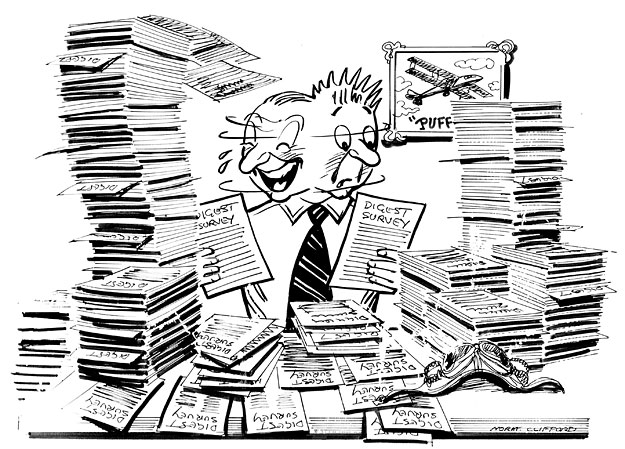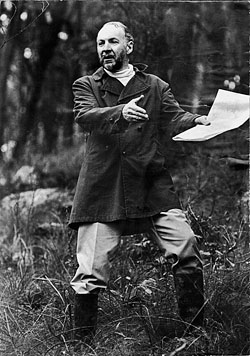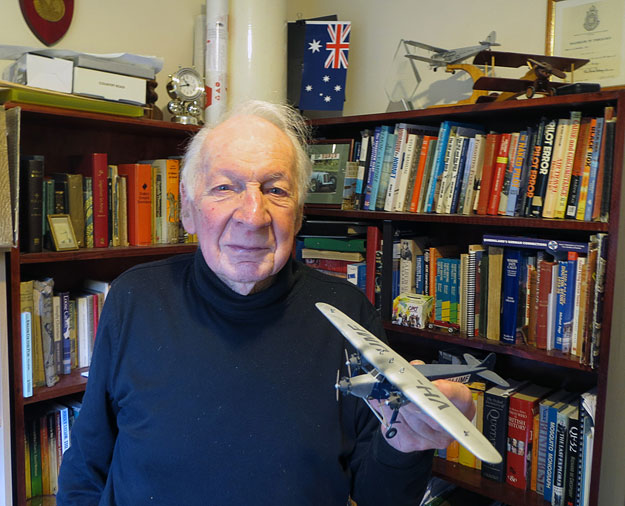
Macarthur 'Mac'
Job
Editor, Aviation Safety Digest 1964-1978,
photographed in 1972
(Photo: Macarthur Job collection)
George Macarthur
'Mac' Job was born in Taree, NSW, on 10 April 1926. Always known as 'Mac', initially
to avoid confusion with his father, also George, he was educated in country NSW
and Sydney. Ambitious to become a pilot, he spent two years in the war-time Air
Training Corps, but on joining the RAAF in late 1944 at the age of 18 he was bitterly
disappointed to be rejected for aircrew because of a slight colour vision defect.
Instead, Mac trained in radio maintenance. The war ended during the final weeks
of his course but, posted to a variety of locations within Australia, he remained
in the Air Force until March 1947.
On discharge he took various civil jobs, but the lure of flying was still great and, after convincing DCA his colour vision was 'safe' after all, he trained for a Commercial Pilot Licence with the Royal Aero Club of New South Wales on Tiger Moths.
Macarthur Job began his working career in civil aviation in March 1954 based in Ceduna, SA, flying De Havilland DH84 Dragon and Percival Proctor III aircraft, and later a Lockheed 12A, with the Anglican Bush Church Aid Society, at that time responsible for Flying Doctor operations in outback South Australia.
In September 1958 Mac began charter operations on the south coast of New South Wales, setting up in business on his own at Merimbula's newly-opened airport, and later expanding into fish spotting for the Eden-based tuna fleet as well as for vessels working in South Australian waters from Port Lincoln.
Appointed to the DCA’s Air Safety Investigation Branch in Melbourne in June 1964, Mac became the first full-time editor of the Department’s principal safety promotion publication, the Aviation Safety Digest. Promoted three years later to the position of Senior Inspector of Air Safety, for 14 years Mac Job presided over the heyday of the famed Aviation Safety Digest, editing (and for the most part writing) issues 36 to 100.
Throughout his time as editor, Mac sought to establish a rapport with his readership by talking to them as fellow pilots in their own language – letting the accidents the Digest reviewed tell their own story, rather than merely lecturing. That he succeeded was admirably borne out – not only by the fact that the Digest was avidly read by 30,000 pilots, aircraft owners and operators, but also by the fact that under his editorship the Digest received the prestigious US Flight Safety Foundation’s ‘Publication of the Year’ award in 1972.
The Norman Clifford cartoon below illustrates Mac at work attending to a reader survey while Editor of the Digest.

Click
here to see some photos of Mac Job with Departmental Cessna
170A VH-CAS. Click here to see a photo of the
Digest editorial team in 1973.
In 1978 Mac Job left the Department to join the editorial staff of the authoritative aviation industry journal Aircraft (established in 1918 and second only to Britain’s Flight in years of publication). Six years later, four of which were spent as Managing Editor of Aircraft, he was appointed a working Director of the Missionary Aviation Fellowship (MAF) – a professional, non-profit organisation which operated more than 40 aircraft in community development work in Papua New Guinea and outback Australia. In 1988 he left this work to become a full-time independent aviation writer specialising in air safety and accident analysis, and an aviation consultant.
Since that time Mac Job has written extensively on the subject in aviation journals and newspapers, and has published numerous books on air safety themes. His work includes: Air Crash, Volumes 1 (1991) and 2 (1992), a seminal study tracing the development of Australia’s airways system from its origin in the years following World War I to today; The Old and the Bold (1994), an anthology of 20 pilot experiences pointing up some of the unpleasant surprises that aviation holds for the unwary, the ill-prepared or the foolhardy; and Air Disaster, four volumes (1994-2001) analysing how the safety of modern air transport has developed through accidents and hard-learned lessons.
As a consultant, Mac Job also worked with the British TV production house Darlow Smithson Productions during the filming of their air safety TV series Black Box, first screened throughout Australia on ABC Television during March 1997, and for legal offices concerned with aviation litigation in both Singapore and Australia.
As a result of his work promoting and educating in the field of air safety, Mac Job has won a number of accolades and awards. At the 1997 Australian International Airshow at Avalon, Vic, he was presented with the Aviation Safety Foundation of Australia’s Aviation Safety Award for "aviation safety excellence" in the ground support category. In the same year, he was also awarded the Aircraft Owners’ and Pilots’ Association’s Bill Adams Trophy, presented each year for "the most outstanding contribution to aviation by an AOPA member."
In the 2003 Queen's Birthday honours Mac Job was awarded the Medal of the Order of Australia (OAM) "for services to the promotion of aviation safety".
Mac Job passed away after battling cancer for several years on Wednesday, 6 August 2014. Shortly before he died, Mac donated his research notes, photographs and aviation library to the CAHS.

Click here to download a finding aid to the Macarthur Job OAM Archive (.pdf).
Left: Mac Job at the Kyeema crash site, c.1970s
Below: Macarthur Job c.1980
Below: Mac holding a model of the Southern Cloud, 24 October 2012 (Photo:
Maurice Austin)

Back to the main Departmental People index
If this page appears without menu bars at top and left, click here